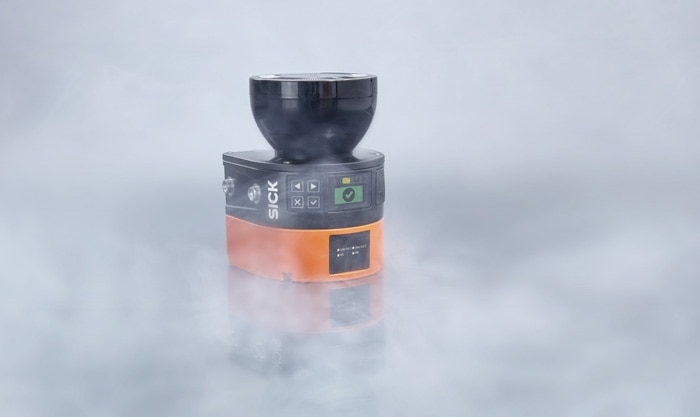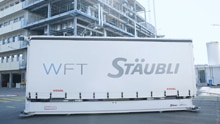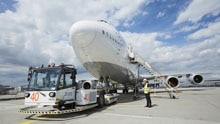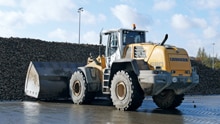Using automated guided vehicle (AGV) systems, BASF is developing intralogistic processes that extend beyond the boundaries of the factory. This globally active chemical company is aiming thereby to increase the productivity and flexibility of the logistics processes at its locations. BASF, SICK and renowned AGV manufacturers are combining their interdisciplinary expertise to work on a concept for an autonomous and seamless logistics chain in the outdoor area.
Outdoor intralogistics taken to a new level: outdoorScan3 at BASF
While visiting SPS IPC Drives 2018 in Nuremberg, Marco Burkhart and Tobias Gaschnitz, two automation engineers responsible for intralogistic design at BASF, closely examined the outdoorScan3 at the SICK booth. The safety laser scanner has been shortlisted as it meets BASF requirements for safe and high-availability human-machine collaboration for the outdoor areas at BASF. The logistics experts at BASF have gained a lot of experience with automated guided vehicle systems. Now they are tackling the next step towards a future with automated outdoor logistics: “We are seeking to implement an outdoor vehicle that can operate autonomously even in difficult ambient conditions and without human monitoring”, explains Marco Burkhart in summarizing the objective of the development project.
Safe interaction between people and machines
The most important aspect, says Tobias Gaschnitz, “is that people and, of course also goods, are fully protected against collisions with often fast and sometimes also heavily loaded vehicles”. At the same time, the safety technology must not curb the availability. To ensure a safe interaction between people and machines, the aim in future is to avoid the use of tactile solutions such as safety edges but instead to employ non-contact smart sensor solutions. The outdoorScan3 is being tested as a possible solution for this.
A large number of challenges need to be overcome to realize this future vision of autonomous logistics. To this end, BASF has brought a number of competent partners on board, including several AGV manufacturers as well as SICK for the safety sensors. BASF has already had good experiences with a whole host of SICK sensors for contour or reflector-based localization, for coarse and fine positioning, for measuring and identifying, as well as for optical data transmission at many of its locations worldwide. “We are impressed with SICK’s competence in smart sensor solutions for intralogistics. It is also ideal that SICK has had a long-standing collaborative relationship with the AGV manufacturers”, explains Marco Burkhart regarding the decision to choose SICK as a testing partner.
With the development of the outdoorScan3 safety laser scanner, we now have available a technology that is extremely resistant to sunlight, rain, snow or fog. Thanks to the outdoor safeHDDM scan technology, the laser scanner can operate without errors when exposed to sunlight with an illumination intensity of up to 40,000 lux. In addition, the intelligent software algorithm of the laser scanner detects rain and snow, easily filtering out these environmental influences – rain, for example, up to a precipitation intensity of 10 mm/h. Even in fog with a meteorological visual range of up to 50 meters, the outdoorScan3 detects all obstacles with total reliability.
Application development for the competing demands of productivity and safety
Since the fall of 2019, BASF has been successively testing the key features of the outdoorScan3 at several manufacturing locations using individually configured test stations in order to globally assess the suitability of the outdoorScan3. SICK has been assisting its customer on-site and from the beginning with the application development for these test stations. In doing so, SICK has been focusing on practice-oriented diagnostics that use remote access and cloud services to provide the best possible automation solution as envisaged by Industry 4.0. Michael Badeja, Product Manager at SICK, explains the approach: “Productivity and safety are two aspects that are always given equal priority in this joint application development with BASF and the AGV manufacturers. Our approach involves two levels: Firstly, we consider the general availability and the mode of operation of the outdoorScan3, and secondly the integration of the device at the system level in the vehicle. We look for the optimal solution for each of these aspects and leverage synergies to derive structural improvements and new approaches which we implement in conjunction with the market”.
Promising availability with remote access feature
The logistics experts rate the results obtained thus far for the test scenario as positive because the general availability of the outdoorScan3 looks promising. The users are able to obtain insights into the location-specific conditions via the remote access feature. This enables them to discuss, for example, the behavior of the outdoorScan3 in rainy conditions and the resultant cumulative object detections. The aim of the interdisciplinary teamwork is to reduce to a minimum the spurious object detections in rainy weather. Particular attention is paid to synergy effects while doing so because a satisfactory solution can only be developed once the outdoorScan3 is installed in the device, and suitable weather protection and organizational measures have been employed.
Condition monitoring – basis for solution approaches
The comprehensive diagnostics, which is essential for finding a successful solution, is made possible through the use of remote access systems from SICK. Thanks to new digital services such as condition monitoring and data analysis, live data from the application and historical data can be visualized, analyzed and interpreted. An analysis of the data is presented in a BASF-specified report on a quarterly basis. Additional weather data enable, through anomaly and pattern detection, the influences on the availability of the outdoorScan3 to be assessed. This enables large data quantities to be distilled down to the essential insights and utilized. Protective field adjustments can be made in a timely manner, and service deployments carried out as required. This increases the availability, and minimizes downtimes over the long term.
Eliminating limitations
But why does the safety laser scanner actually switch off? This is where the requirement for functional safety sensors can help. Via self-diagnostics in the device and smart algorithms, the safety laser scanner needs to continuously monitor the ambient conditions and its reliable operational status in order to guarantee the high Pl d safety level (ISO 13849-1) even for outdoor areas. This can result in a limited availability under certain ambient conditions because the quality of the measurement data cannot be assured. These limitations can be eliminated through additional equipment on the scanner and vehicle, e.g., by means of protective hoods.
After the very promising static tests at the sensor stations, the stress testing of the outdoorScan3 at BASF is now progressing to the next phase: the device will soon be mounted on the automated guided vehicles to perform further application-specific testing and to prepare the system for productive operation. For all parties involved, this will be an exciting next step on the path towards the future of autonomous outdoor logistics.
Read more
Autonomous intralogistics from indoors to outdoors: SICK and Stäubli WFT provide a seamless logistics chain for BASF
Industry 4.0 je na vzestupu: senzorová řešení pro mobilní platformy
Naše modulární portfolio řešení pro mobilní platformy nyní umožňuje jednoduchou realizaci vedení v dráze, navigace, polohování, detekce prostředí, bezpečnosti a manipulace s břemeny.













